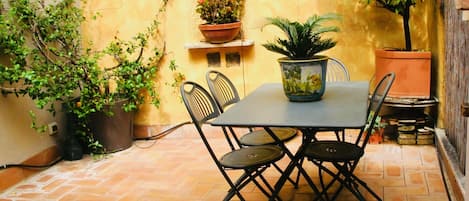Stylish loft with patio located in the very heart of the center in the famous, secluded and mesmerizing Arco degli Acetari, an hidden little square with huge historical importance, steps away from the iconic Campo de' Fiori. The square is surrounded by old little houses with peculiar balconies full of flowers. The apartment features a private entrance, an open space living room with a bed and a dining area, a small separated kitchen, a bathroom with shower and a private patio with dining table.
Among the countless medieval architectures that can be admired in Rome there are some which, due to their central position and the aura of mystery that often fills them, have had great success among both citizens and tourists: one of these it is certainly the "Arco degli Acetari", a stone's throw from Piazza Navona.
The charm of the place comes from the fact that in the square, which is accessible through an arch, it feels like time has stopped and this is probably also thanks to the fact that the area is not directly accessible by road. In fact, you have to go past number 19 of Via del Pellegrino and enter the buildings to discover the enchanted atmosphere that this courtyard can offer: the external stairs typical of medieval houses, the warm ocher plaster and the nature that blends perfectly with the the architecture helps make this place even more picturesque.
The term 'Acetari' has not been well attested, however it is believed that it derives from 'Acquacetosari', later called 'Acetosari', i.e. the sellers of Acetosa Water which was presumably distributed at the adjacent Campo de' Fiori market. The vinegary component of this water was considered curative as is reported in the fountain commissioned by Pope Paul V Borghese, near the source in Tor di Quinto, where there is a plaque with the inscription: RENIBVS ET STOMACHO SPLENI IECORIQVE MEDETVR MILLE MALIS PRODEST ISTA SALVBRIS AQVA (This healthy water cures the kidneys, stomach, spleen, liver and helps a thousand other ailments). In the XVII century Pope Alexander VII Chigi also particularly appreciated this water so much that he dedicated a monumental travertine exedra to it.







